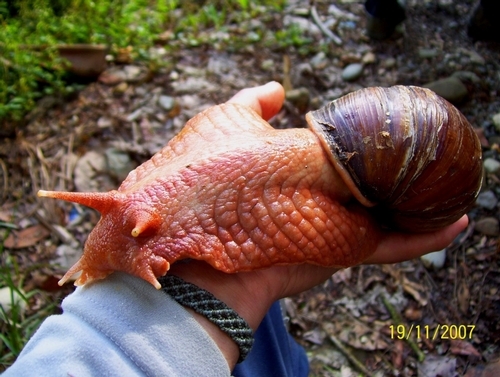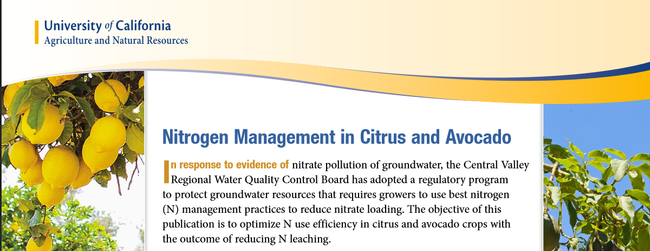
Posts Tagged: avocado citrus
Wet Roots
I recently harvested 'GEM' avocados and found that some of the fruit was splitting. The split fruit was just turning from a bright green to one with dark tinges. There were also gobs of snails and slugs on the fruit. I mentioned the cracking fruit to a grower who had been harvesting ‘Hass' fruit and the comment was that their fruit was turning black on the tree and falling. This is way early for ‘Hass' to show this level of maturity.
Several mandarin growers also mention peel breakdown or rind disorder. There can be brown, water-soaked blotches or dark, sunken areas developing on the rind after rainy weather. The fruit matures rapidly, turning orange early. Secondary fungi can then colonize the affected areas. It's more of a problem in northern California where thin-skinned satsumas are grown and there are early rains. But accelerated maturity and fruit/whole plant breakdown can happen on all citrus and many other fruiting plant species.
This is another example of accelerated maturity due to wet roots. The roots need air, like we do, and when they are asphyxiated for even short periods of time, they start signaling the rest of the plant that something is wrong. Prolonged rainy periods or actual ponding conditions will lead to ethylene precursors that start the maturation process – “banana in a bag” effect. This is in spite of many crops being delayed in their maturity because of the cold winter we have had. Drown the roots, and they start responding as if they are choking. They are. In some cases, leaves will droop (epinasty or wilting) and drop, immediately. And then the fruit may drop right away or then just start rapidly maturing/ripening on the tree. Once this process starts, there's no stopping it. Some growers, seeing fruit drop have gone out to start harvests, but then inadvertently gotten their forklifts stuck in the mud. Rain can have its downsides.

mandarin rind disorder

lemon cold wet exposure
Cultural Practices to Reduce Pest and Disease in Avocado & Citrus
In many ways our pest and disease management of fruit tree crops are exacerbated by our cultural practices. Avocado and citrus offer some very clear demonstrations of how we manage our trees can lead to reduced pesticide use. From the beginning, our selection of rootstock and scion can help lessen pest and disease problems. In both avocado and citrus we have good rootstocks which can handle problems, such as root rot more effectively than seedling rootstocks. So it is imperative that if you know that drainage will be a problem, starting off with the right, healthy rootstock helps. Also scion selection can have a major impact, as well. For example, ‘Lamb' avocado is much less prone to persea mite than is ‘Hass'. This pest can significantly impact a spray program and planting ‘Lamb' could mean virtually no sprays for this pest. Selling the ‘Lamb' fruit is then the challenge There are similar examples in citrus where one variety is more prone to a pest or disease than another.
Irrigation is probably the most important cultural factor in managing tree disease. Over, under and improperly timed irrigations are the conditions necessary for many root diseases. The Phytophthora spp. fungi are looking for distressed root systems brought on by waterlogging and other stressful situations. Other conditions, such as wetted trunks can also bring on some trunk diseases, like gummosis in citrus and crown rot in avocado. Simply preventing irrigation water on the trunks can limit these diseases. Other diseases, such as black streak, stem blight and bacterial canker in avocado are bought on by soil moisture stress.
Nutrients, especially nitrogen management, has been long known to affect levels of insects, such as scale, mealy bug and aphid. Encouraging lush growth helps sustain these insects, so reducing this growth tends to lower their numbers. Managing when canopy growth occurs can affect pest severity. Avocado thrips build their populations in the spring and moves easily from leaf to fruit causing significant scarring. By promoting leaf growth at flowering time with a nitrogen application, keeps the insect on the leaves and reduces fruit scarring. This also promotes growth that replaces leaves that have been damaged by persea mite. Likewise the incidence of citrus leaf miner damage can be reduced if spring pruning is avoided so that a flush of growth does not occur at the same time as the population is building. Timing of pruning is important in lemons to avoid wet periods of rain and fog to reduce the spread of hyphoderma wood rot fungus when its fruiting bodies are active.
Pruning can change pest pressure by changing the humidity in the canopy, introducing light and changing the climate supporting disease and pests. By making spray coverage more thorough, it also makes for a more effective application. Modified skirt pruning can have significant effects on mealy bug and scale control, fuller rose weevil incidence, ant colonization and snail damage. It's important that the trunk be protected as an avenue of movement for snail and ant control to get the best effects of this pruning. Skirt pruning also reduces problems with such weeds as bladder pod and the ladder effect of brown rot in citrus – fungal propagules splashed from the ground onto low-hanging fruit, which in turn is splashed to higher fruit.
Keeping a canopy clean of dust and fire ash also makes for more efficient biological control. Because predators are slowed in their search, they are less efficient. They also spend more time grooming their sensory organs, and this also slows them down. Parasites such as wasps are actually slowed by the physical abrasion to their tarsi. Dust also creates a drier environment, which is more hospitable to our pest mites. Watering picking rows, roads and even the trees themselves can lessen mite populations. Use of cover crops can also reduce dust and potentially provide pollen and nectar for predators and parasites. Of course cover crops create a whole new set of management issues, such as colder winter orchards and snails.
Finally harvest timing to avoid pest and disease is often overlooked. In avocado, fruit is often set in clusters. Greenhouse thrips love the microclimate created, and if in a size-pick the cluster is reduced, greenhouse thrips will often not be a problem. Harvest timing is also important in citrus. Fruit left too long on the tree can often develop septoria fungal spot. Picking in a timely manner reduces the incidence of this disease.
These are just a few examples of how cultural practices at the right time can reduce pest and disease problems.

avocado pruning
Nitrogen Management in Citrus and Avocado Publication
Nitrogen is the nutrient plants require in the largest quantity for better yield and quality. Nitrogen is also an integral constituent of proteins, nucleic acids, chlorophyll, co-enzymes, phytohormones,and secondary metabolites, and its deficiency can negatively affect yield. Nitrogen-deficient plants are stunted, with narrow, small, pale leaves. Excessive N application increases vegetative growth and susceptibility to diseases that infect fruit, kill spurs, and reduce yields in subsequent years. Managing nitrogen is critical to tree health and productivity, and active understanding of how it plays in the general horticulture of the tree is critical.
In response to evidence of nitrate pollution of groundwater in California, the various Regional Water Quality Control Boards have adopted regulatory programs to protect groundwater resources that requires growers to use best nitrogen (N) management practices to reduce nitrate loading. As a help to growers, this publication has been created to optimize N use efficiency in citrus and avocado crops with the outcome of reducing N leaching.
Winter Yellows
Several calls have come in from growers lately about yellow avocado and citrus trees. the yellowing is most common on the late summer flush leaves or can affect the whole canopy on young trees. In severe cases leaves fall. This happens going into winter after a warm fall when growing conditions are good. During the winter, the root systems become depleted of stored starch and die.
During winter, trees go into what is called a “quiescent” state, a version of dormancy found in subtropical tree crops. This is a resting mode that protects them to a certain degree from frost damage. There is not much that can be done in a field setting until temperatures warm up and the trees begin growing again in late winter/early spring. As the temperatures increase, the trees gradually recover and the foliage re-greens.
Winter Yellows can be exacerbated in years when we do not have leaching rains to remove salts from the root zone. And it can also be more severe when we have those years when winter rains just never seem to stop and rootzones become waterlogged. We may never see that time again.
Photo by Greg Moulds

citrus winter yellows
Five Snail Speakers for the Price of One
Snails and Slugs (May 22, 2019 from 3-4pm)
Presenters: (!) Dr. Cheryl Wilen (UC IPM), (2) Dr. Rory Mc Donnell and (3) Dr. Dee Denver (Oregon State University), (4) Dr. Adler Dillman and (5) Dr. Irma De Ley (UC Riverside). The webinar will cover an overview of snail and slug biology, damage and management with emphasis on brown snail and Italian white snail, and current research on slug biocontrol using nematodes. One DPR CE unit (other) and one CCA CE unit (IPM) are approved.
And What Else Are the
UC Ag Experts
Talking About? 

| Event Name | Date |
|---|---|
| UC Ag Experts Talk: Snails and slugs | 5/22/2019 |
| Uc Ag Experts Talk: Management of Weeds in Citrus Orchards | 6/19/2019 |
| UC Ag Experts Talk: Citrus Dry Root Rot | 7/24/2019 |
What is involved in the webinars?
A series of 1 hour webinars, designed for growers and Pest Control Advisors, will highlight various pest management and horticultural topics for citrus and avocados. During each session, a UC Expert on the subject will make a presentation and entertain write-in questions via chat during and/or after the presentation. As we develop this program, we may expand to other crops.
Topics: pests and diseases of citrus, avocado and other crops
And Next up is:
Management of Weeds in Citrus Orchards (June 19, 2019 from 3-4pm)
Dr. Travis Bean, assistant weed science specialist in UCCE, will discuss the importance of weed management in citrus, tree age and variety considerations, scouting and weed identification, cultural and mechanical practices, and pre- and post-emergence herbicides. One DPR CE unit (other) and one CCA CE unit (IPM) are pending.
Register in advance for the webinars by clicking on the event links above.
Are there Continuing Education units?
When the subject discusses pest or disease management, continuing education units will be requested from DPR (1 unit per session). Participants will pre-register, participate in the webinar and be awarded the unit. The sessions will be recorded and hosted on this web site for future study. However, continuing education units will be awarded only to the participants who attend the live version of the webinar.
Who is involved?
This webinar series is brought to you by Ben Faber (UC ANR Ventura Advisor) and Dr. Beth Grafton-Cardwell (Depart of Entomology UC Riverside Extension Specialist) with the technical support of Petr Kosina (UC IPM Contect Development Supervisor) and Cheryl Reynolds (UC IPM Interactive Learning Developer).

giant land snail

